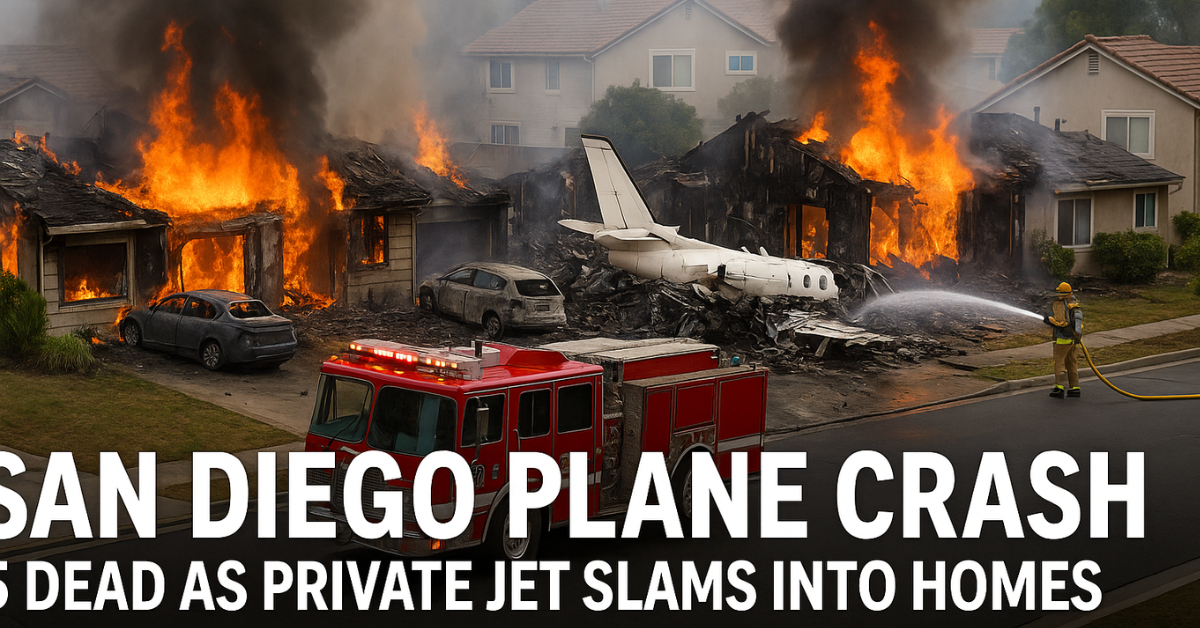San Diego Plane Crash: 5 Dead as Private Jet Slams Into Murphy Canyon Homes
In the quiet pre-dawn hours of May 22, 2025, San Diego’s Murphy Canyon neighborhood awoke to a nightmare. A Cessna 550 Citation II private jet, moments from landing at Montgomery-Gibbs Executive Airport, plummeted from the sky and crashed into a densely populated residential area. The result was catastrophic: five lives were lost — all believed to be passengers aboard the aircraft — and at least 15 homes were damaged or destroyed by the resulting fire and debris.
This tragic aviation disaster not only shook the immediate community but also reignited national conversations about flight safety, particularly for small private jets operating in urban environments.
San Diego Plane Crash Details: What Happened?
The private jet, registered in Alaska and built in 1985, departed from Colonel James Jabara Airport in Wichita, Kansas. According to the Federal Aviation Administration (FAA), the aircraft was on its final approach to Montgomery-Gibbs Executive Airport in San Diego when the crash occurred at around 3:45 a.m. local time.
Dense fog and low visibility in the region are suspected to have played a significant role in the crash. Weather reports from the San Diego National Weather Service confirmed that visibility had dropped to less than half a mile during the early morning hours.
Initial investigation data shows no distress signal or mayday call was made. The pilot’s last communication with air traffic control was a standard position report, stating they were three miles out from the airport. Tragically, minutes later, the jet veered off-course and nosedived into the Murphy Canyon area.
San Diego Plane Crash Location of Impact: Murphy Canyon Neighborhood
Murphy Canyon is home to many military families due to its proximity to Marine Corps Air Station Miramar. The plane crashed near the intersection of Sculpin Street and Santo Road, causing fires to erupt across several properties.
San Diego Fire-Rescue Chief Colin Stowell stated that 15 homes were directly impacted, with flames consuming the structures before fire teams could fully contain the blaze. Over 100 residents were evacuated as a precaution, and power lines in the area were also damaged, leading to temporary outages.
Despite the enormous destruction, there were no injuries reported among residents on the ground, a fact credited to both the early hour and quick emergency response.
Casualties and Victims Identified
Authorities have confirmed that five individuals aboard the aircraft died on impact. Their identities have not yet been released, pending notification of next of kin. The jet had a maximum seating capacity of eight, and it was carrying only five people — including the pilot and co-pilot — at the time of the crash.
According to FAA regulations, the plane was certified for both commercial and private operation. It is currently unclear whether the jet was operating as a charter flight or a private transport.
As of this writing, no ground casualties or injuries have been reported, an outcome described by emergency officials as “miraculous” given the densely packed homes in the crash zone.
Emergency Response and Firefighting Efforts
Firefighters arrived on the scene within minutes of the first 911 calls, battling multiple blazes across the crash site. According to the San Diego Fire Department, it took more than four hours to bring the situation under control. By 7:30 a.m., all but one of the fires had been extinguished.
Evacuation zones were quickly established, and residents were instructed to avoid the area. Two elementary schools in the neighborhood suspended classes for the day due to smoke and safety concerns.
The Red Cross and city agencies have since set up emergency shelters for displaced residents. Food, blankets, and counseling services are being offered as the community processes the shock of the tragedy.
Investigation: What Comes Next?
The FAA and the National Transportation Safety Board (NTSB) are jointly leading the investigation. Preliminary findings point toward a combination of poor visibility, terrain proximity, and possibly technical malfunction or pilot error. However, officials have cautioned that it may take weeks or even months to reach a conclusive determination.
Flight data and cockpit voice recorders, if present and recoverable, will be vital in understanding what went wrong. Investigators are also reviewing weather patterns, maintenance logs, and the pilot’s experience and credentials.
“We want to be thorough and transparent,” said an NTSB spokesperson. “The public deserves clear answers about why this happened and how to prevent it in the future.”
Community Reaction: Resilience Amid Tragedy
Local leaders and residents have expressed grief, shock, and unity in response to the crash. San Diego Mayor Todd Gloria issued a statement Thursday afternoon:
“This is a heartbreaking day for San Diego. While we mourn the lives lost, we are grateful for the swift action of our first responders and the strength of our community in the face of tragedy.”
Social media platforms have been flooded with messages of support, and several GoFundMe campaigns have been launched to help affected families rebuild their homes and lives.
Private Plane Safety Under Scrutiny
The San Diego crash has raised renewed questions about the safety of private jets, particularly older models like the 1985 Cessna Citation II. While private air travel remains statistically safer than driving, incidents like these highlight the vulnerabilities involved, especially in poor weather and when flying over residential zones.
Experts suggest that further FAA regulations or technology upgrades, such as enhanced vision systems or automatic terrain warnings, may be needed to ensure safety for both passengers and those on the ground.
Mourning, Recovery, and a Call for Change
The Murphy Canyon plane crash is a stark reminder of how quickly tragedy can strike — even from the sky. With five lives lost and many families displaced, San Diego now begins the slow process of healing and rebuilding.
As investigators search for answers and the community pulls together, the nation watches closely, hopeful that lessons from this heartbreaking event will lead to improved safety protocols and greater accountability in private aviation.

